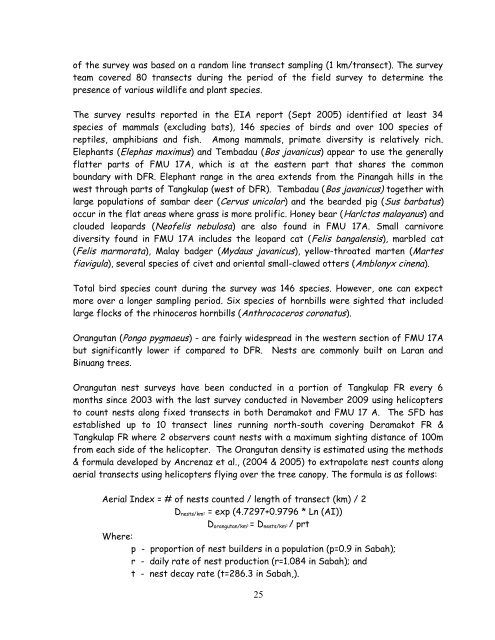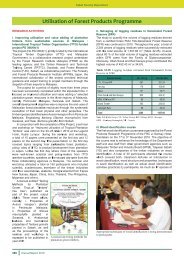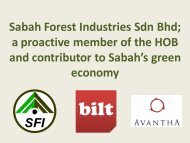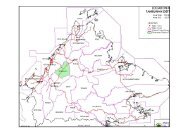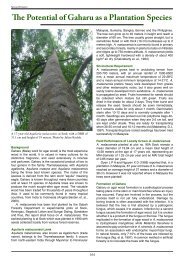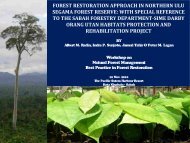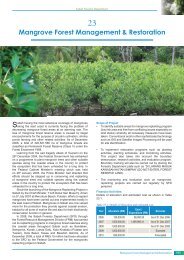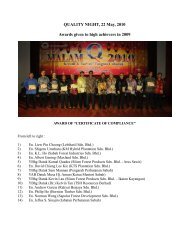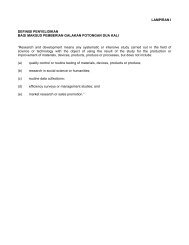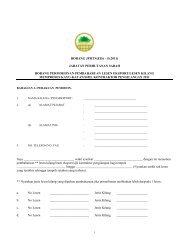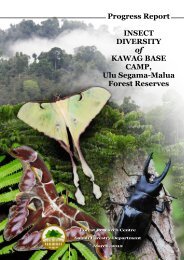Forest Management Plan - Sabah Forestry Department
Forest Management Plan - Sabah Forestry Department
Forest Management Plan - Sabah Forestry Department
Create successful ePaper yourself
Turn your PDF publications into a flip-book with our unique Google optimized e-Paper software.
of the survey was based on a random line transect sampling (1 km/transect). The surveyteam covered 80 transects during the period of the field survey to determine thepresence of various wildlife and plant species.The survey results reported in the EIA report (Sept 2005) identified at least 34species of mammals (excluding bats), 146 species of birds and over 100 species ofreptiles, amphibians and fish. Among mammals, primate diversity is relatively rich.Elephants (Elephas maximus) and Tembadau (Bos javanicus) appear to use the generallyflatter parts of FMU 17A, which is at the eastern part that shares the commonboundary with DFR. Elephant range in the area extends from the Pinangah hills in thewest through parts of Tangkulap (west of DFR). Tembadau (Bos javanicus) together withlarge populations of sambar deer (Cervus unicolor) and the bearded pig (Sus barbatus)occur in the flat areas where grass is more prolific. Honey bear (Harlctos malayanus) andclouded leopards (Neofelis nebulosa) are also found in FMU 17A. Small carnivorediversity found in FMU 17A includes the leopard cat (Felis bangalensis), marbled cat(Felis marmorata), Malay badger (Mydaus javanicus), yellow-throated marten (Martesfiavigula), several species of civet and oriental small-clawed otters (Amblonyx cinena).Total bird species count during the survey was 146 species. However, one can expectmore over a longer sampling period. Six species of hornbills were sighted that includedlarge flocks of the rhinoceros hornbills (Anthrococeros coronatus).Orangutan (Pongo pygmaeus) - are fairly widespread in the western section of FMU 17Abut significantly lower if compared to DFR. Nests are commonly built on Laran andBinuang trees.Orangutan nest surveys have been conducted in a portion of Tangkulap FR every 6months since 2003 with the last survey conducted in November 2009 using helicoptersto count nests along fixed transects in both Deramakot and FMU 17 A. The SFD hasestablished up to 10 transect lines running north-south covering Deramakot FR &Tangkulap FR where 2 observers count nests with a maximum sighting distance of 100mfrom each side of the helicopter. The Orangutan density is estimated using the methods& formula developed by Ancrenaz et al., (2004 & 2005) to extrapolate nest counts alongaerial transects using helicopters flying over the tree canopy. The formula is as follows:Aerial Index = # of nests counted / length of transect (km) / 2D nests/km² = exp (4.7297+0.9796 * Ln (AI))D orangutan/km² = D nests/km² / prtWhere:p - proportion of nest builders in a population (p=0.9 in <strong>Sabah</strong>);r - daily rate of nest production (r=1.084 in <strong>Sabah</strong>); andt - nest decay rate (t=286.3 in <strong>Sabah</strong>,).25


